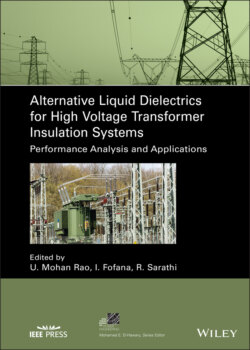Читать книгу Alternative Liquid Dielectrics for High Voltage Transformer Insulation Systems - Группа авторов - Страница 64
2.6.1.4 Duval’s Triangle
ОглавлениеThe Duval Triangle uses three hydrocarbon gases only, namely methane (CH4), ethylene (C2H4), and acetylene (C2H2), to detect the fault types [75, 76]. The concentration of the gases is plotted in a triangular coordinate system. The types of faults detected by the Duval’s triangle method are given in Table 2.10. The coordinates of the fault are denoted by the points A1=%p1, A2=%p2, A3=%p3 for the percentage concentration of CH4, C2H4, and C2H2 gases, respectively. The concentration of gases in ppm are considered for CH4 = p1, C2H4 = p2, and C2H2 = p3 and are converted to triangular coordinates. The relative proportion of the three gases is calculated as below:
(2.18)
Table 2.9 Types of faults by Rogers ratio method.
| No. | Type of fault | R1 | R5 | R2 |
|---|---|---|---|---|
| 1 | No fault | 0.1 < R1 < 1 | R5 < 1 | R2 < 0.1 |
| 2 | Partial Discharge with low energy density | R1 < 0.1 | R5 < 1 | R2 < 0.1 |
| 3 | Arcing with high energy discharge | 0.1 ≤ R1 ≤ 1 | R5 > 3 | 0.1 ≤ R2 ≤ 3 |
| 4 | Low temperature thermal faults | 0.1 < R1 < 1 | 1 ≤ R5 ≤ 3 | R2 < 0.1 |
| 5 | Thermal faults of temperatures < 700 °C | R1 > 1 | 1 ≤ R5 ≤ 3 | R2 < 0.1 |
| 6 | Thermal faults of temperatures >700 °C | R1 > 1 | R5 > 3 | R2 < 0.1 |
Table 2.10 Types of faults.
| No. | Type of fault | Symbol |
|---|---|---|
| 1 | Partial discharge with low energy density | PD |
| 2 | Discharge (arc) with low energy | D1 |
| 3 | Discharge (arc) with high energy | D2 |
| 4 | Mixture of electrical and thermal faults | DT |
| 5 | Thermal faults of temperatures <300 °C | T1 |
| 6 | Thermal faults of temperatures between 300 and 700 °C | T2 |
| 7 | Thermal faults of temperatures >700 °C | T3 |
| 8 | Overheating | O |
| 9 | Stray gassing | S |
| 10 | Hot spots with carbonization of paper | C |
where k = 1, 2, 3 as per the three gases mentioned above.
The quantity of cases with NEO‐filled transformers is less, so to assess the state of transformer with evolution of the various gases, creating the conditions replicating the inside of the transformer offers fruitful results. The different combinations of gases evolve depending on the temperatures created by the faults. PD is indicated by the formation of H2 and CH4 at low temperatures, whereas arcing faults are indicated by the formation of C2H2 at high temperatures. When the solid insulation deteriorates and reacts with the insulating oil, the gases like CO and CO2 are formed. A gas chromatograph (GC) is used to measure the extracted gases in the oil. Some studies show the results of DGA of two types of NEOs, namely FR3 and JAT, in Figure 2.12a and b [73]. The total gas content (TGC) is calculated using the formula:
(2.19)
The H2 production is not very significant in both oils, but it is higher in the case of FR3. The insignificant concentration of H2 gas even after 2000 hours of aging makes the JAT less flammable compared with FR3. A few works show that the higher concentration of C2H6 may be due to faults at low temperatures below 150 °C. C2H4, which is the chief indicator for high‐energy thermal faults, is comparable for both oil types. The presence of solid insulation on reaction with the oil produces CO and CO2 in significant amounts, which indicates cellulose degradation. This happens because paper starts degrading at temperatures above 105 °C and the aging atmosphere influences the deterioration of oil [73]. The gas levels are quite substantial in the case of jatropha oil which might indicate that solid insulation is better safeguarded by FR3. Also, in general, the concentrations of all the gases in this oil increased with the aging duration. The small variations in gas concentrations can be ascribed to the different origination of these oils. The Duval Triangle 3 (recommended for non‐mineral oils) is used for both NEOs, as formulated by Michel Duval. The two NEOs are based on the different compositions of saturated and unsaturated oleic and fatty acids, which result in different patterns of gas generation. In the Duval Triangle 3, CH4, C2H4, and C2H2 are selected as the sides 3. The fault gas data are replaced into it, and it is observed from Figure 2.12c, that all of the data points for both oil types fall in corresponding thermal faults region. In some circumstances, the data points lie in the boundary regions and it becomes challenging to identify the actual faults. Also, many times stray gases are produced at temperatures below 200 °C in the PD, T1, or T2 zones, and consequently may affect the correct detection of these faults [22]. For analysis purpose of low‐temperature faults, Duval Triangle 6 uses the low‐energy gases (H2, CH4, and C2H6) as represented in Figure 2.12d. It is seen that stray gassing occurs in FR3 for all aging durations, however, for JAT, overheating is observed.
